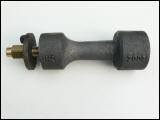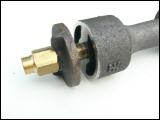Burner assembly #2
Raku burner set #2 is available with three different capacities 25, 35 and 45 kW which ever suits you the best.
This burnerset can also be delivered with Raku Kiln Type 260 against additional costs. This make the firng time even shorter than with the standard burner set. Or it allows you to fire the kiln on a higher temperature which is an advantage for copper mate techniques. Also a bigger burner capacity together with the primairy air reduction valve makes it easier te create a reduction atmosphere in the kiln.

The interchangeable gas nozzle makes it possible to adapt the capacity of the burner to the size and type of Raku kiln you have.
Changing the gas nozzles is easy and can also be done afterward, which is also recommended to do in case you fire with different types / sizes of kilns.
If you apply a burner capacity which is too big compared to the size of the kiln it will be impossible to have a graduate temperature rise in the kiln. But it will also be difficult to maintain a good oxidised atmosphere in the kiln with a lot of problems and dissapointments in the glaze results you get.
Like the consideration we give when chosing a kiln we also want to state here that also here the biggest capacity is not alway's automatically the best choice.

Burner #2 6800 - 25 kW/0,6 Bar
| Gas pressure | Burner capacity | Gas consumption |
| Bar | kW | Kg/h |
| 0,2 | 14 | 1,0 |
| 0,4 | 20 | 1,5 |
| 0,6 | 25 | 1,8 |
| 0,8 | 29 | 2,1 |
Burner #2 9700 - 35 kW/0,6 Bar
| Gas pressure | Burner capacity | Gas consumption |
| Bar | kW | Kg/h |
| 0,2 | 21 | 1,5 |
| 0,4 | 29 | 2,1 |
| 0,6 | 36 | 2,5 |
| 0,8 | 41 | 2,9 |
Burner #2 13000 - 45 kW/0,6 Bar
| Gas pressure | Burner capacity | Gas consumption |
| Bar | kW | Kg/h |
| 0,2 | 28 | 2,0 |
| 0,4 | 39 | 2,8 |
| 0,6 | 48 | 3,4 |
| 0,8 | 56 | 4,0 |
Description
Propane burner
The propane burner consists of: (1) brass threaded connection piece, (2) interchangeable gas nozzle, (3) reduction valve, (4) cast iron ventury tube.

(1) Brass treaded connection piece.
The brass treaded connection piece (wrench Nr. 22) has a 3/8" male threat for connection to the shut off valve. In addition the connection piece has a threaded rod for the reduction valve to be closed. The front of the connection piece is has a female threat for the interchangeable gas nozzle (wrench Nr. 10).

(2) interchangeable gas nozzle.
The gas nozzle (wrench Nr. 10) can be changed thus adapting the burner capacity to the kiln.
We have 3 different gas nozzle types available:
Type 6800 - 25 kW/0,6 Bar
Type 9700 - 35 kW/0,6 Bar
Type 13000 - 45 kW/0,6 Bar
The bore in the gas nozzle must be kept clean. Dirt in the gas nozzle that reduces the bore diameter will have a negative influence on the burner performance. The nozzle is however easy to remove and cleaned. The use of gas sealing tape when re-fitting the nozzle is not necessary.

(3&4) Reduction valve & ventury tube.
Due to the shape of the ventury tube, air will be drawn towards the propane flame as soon as propane gas is being injected by the through the gas nozzle. By gradually closing the air intake openings at the end of the ventury tube by closing the reduction valve the ratio between gas and air can be influenced such that a reductive environment will occur in the kiln.

Adjustable pressure regulator
The pressure regulator reduces the gas pressure as it is in the gas tank to a suitable pressure for the burner.
Because the pressure regulator is adjustable we can control the gas pressure given to the burner and with it the firing of the kiln.
The pressure regulator is connected to the gas tank with a Shell coupling nut (Wrench Nr.30). This nut has "left" female threat which common practice with gas connections.
Check every time you connect the pressure regulator that the gasket inside the nut is in position, even when the tank connection itself is also fitted with a gasket. The latter one does not replace the gasket of the pressure regulator.
After you have tighten the coupling nut by hand you can give some additional torque with the wrench but there is no need for a lot force here. Tight is tight.
The normal operating pressure area of the burner lies between 0 and 0,8 bar with a max. of 1,5 bar.
It is recommended to apply a bit of silicon spray every now and then to the adjusting lever to keep it smooth going.
Propane hose
Length of the hose is approx. 3m. and it is fitted with a coupling nut (Wrench Nr.19) to the pressure regulator. Also here left threat is applied so loosening and tightening goes exactly in the other direction as you are used to. This connection has no gasket but has to be sealed by torque. Tighten the nut with your hand and apply additional torque with the wrench. But do not overdo this. Tight is tight
Check before firing the condition of the hose. If you see changes in colour or cracks in the hose then you need to replace it.
The year of manufacturing is printed on the hose. In general recommendation is to replace hoses older than 2 years.
Price of the spare hose is to be found in Price list Nr. 3 Kiln Building.
Shut off valve
The gas flow to the burner can be shut off with this valve.
-Is the grip of the valve positioned in the direction of the gas flow then the valve is opened.
-With the grip at a 900 angle to the flow direction the valve is closed.
The valve is not intended to regulate the amount of gas to the burner by having it half or partly opened. Regulating the burner is only done with the pressure regulator.
Between two firing sessions it is enough to have just this valve closed. The valve of the gas tank can stay opened. Of coarse before disconnecting the burner the tank valve should always be closed.

Pressure regulator
(C) 2005 - All rights reserved